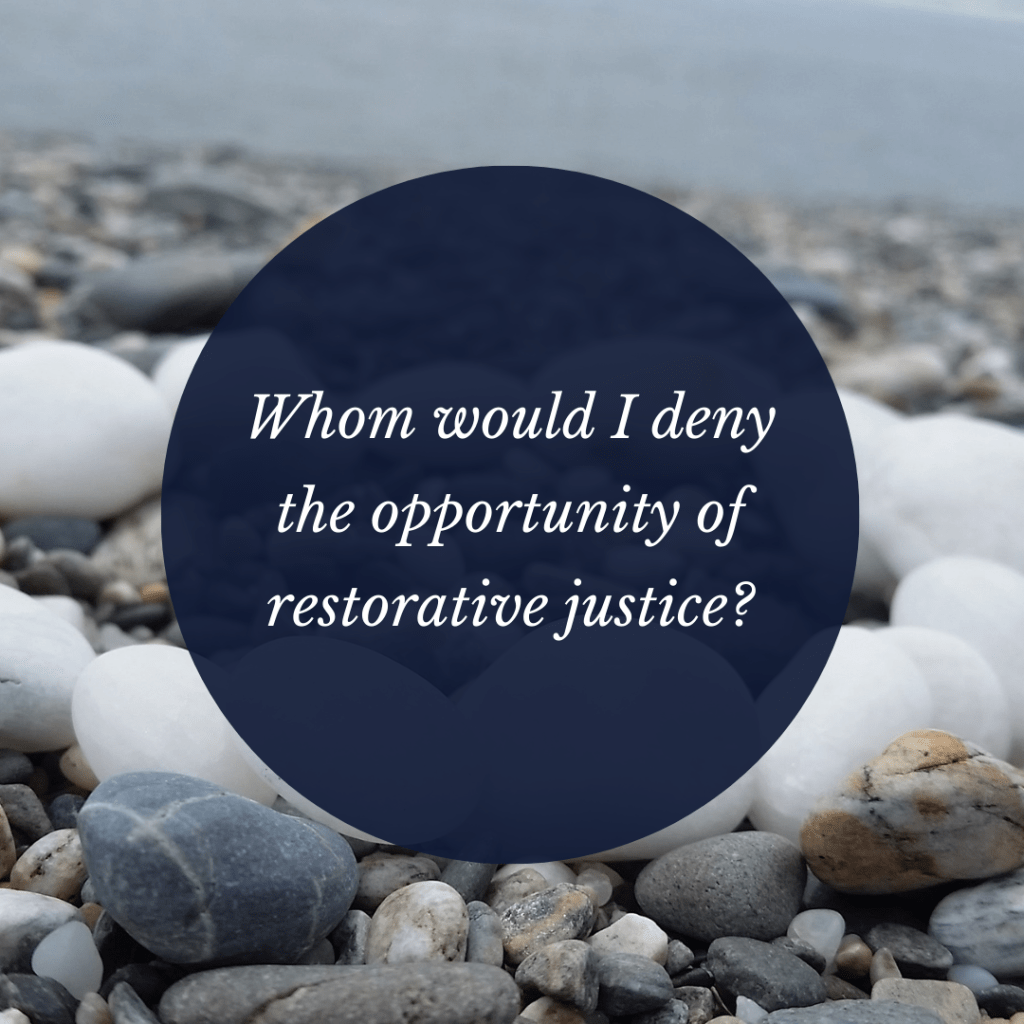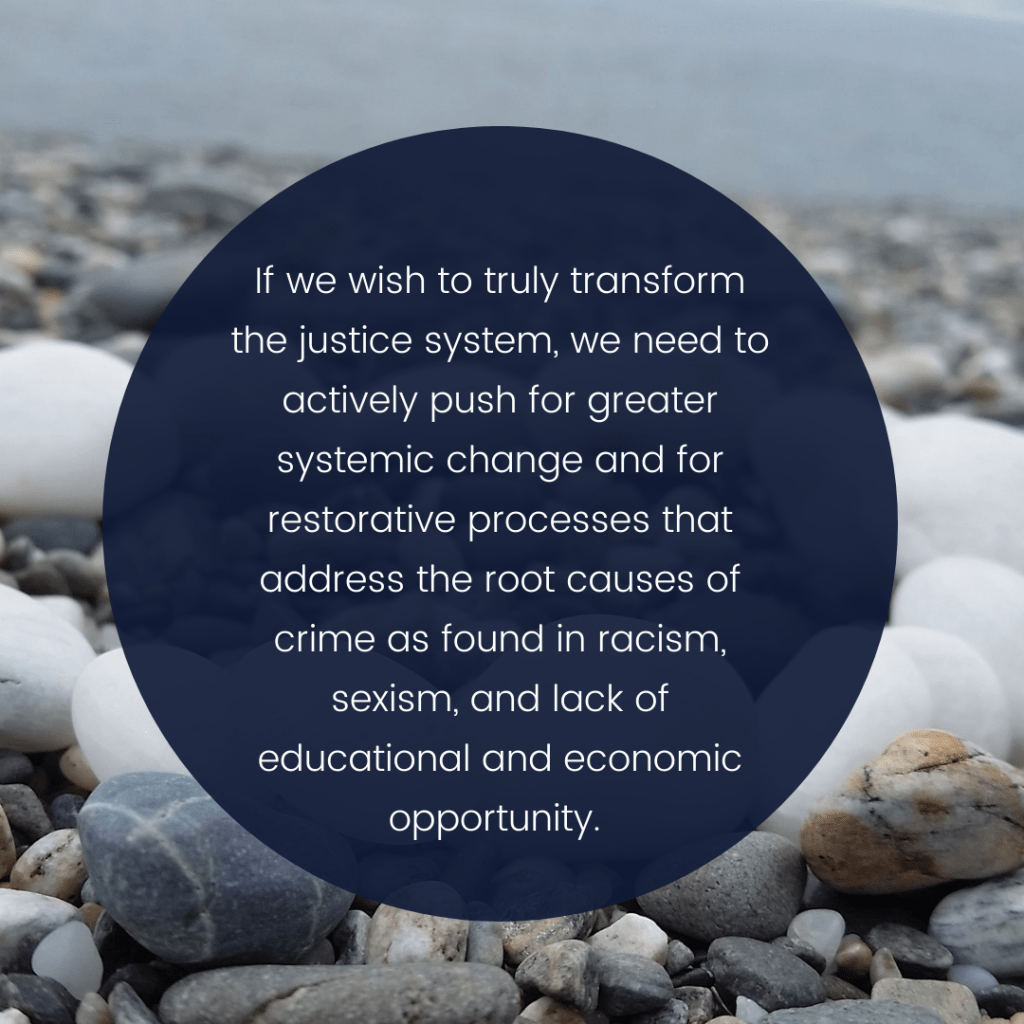Generally, the conversation about which cases should not be referred to restorative justice quickly turns to the crimes considered more severe or complicated such as sexual assault, domestic violence, or murder. Practitioners and advocates have a wide range of opinions about where restorative justice should “draw the line” with some seeing it as only an appropriate response for minor offenses or juveniles and some seeing restorative justice as an appropriate option for any incident of harm in which responsibility is being taken, further harm can be avoided, and the involved parties would like to engage in a restorative process.
Personally, my own thinking on this debate hinges on one question: Whom would I deny the opportunity of restorative justice? If in any given case, the responsible and harmed parties feel that a restorative justice process would be helpful to their own healing journeys and that process can be carried out safely with the support of well-prepared facilitators, then I do not think anyone should be denied the option of restorative justice.
However, there are times that a restorative justice process is not an appropriate response and can end up causing additional harm to all involved. Generally, these are crimes that are considered less severe, involving minor misdemeanors and often juveniles. Referrals of cases like these are all too common in restorative justice programs across the United States and proceeding with these referrals risks causing further harm to those involved and may damage the public’s trust in the restorative justice movement as a whole.
When Restorative Justice Widens the Net
One category of cases that should not be referred to restorative justice are cases that “widen the net.” These are cases that would have otherwise been handled with a warning or through an internal community process, but because restorative justice is an option, end up becoming further entangled in the criminal justice system.
For example, I recently heard about a fight at a school involving two 13-year-olds that was referred to a community restorative justice program. This restorative justice program has the (very common) rule that if a responsible party reoffends at any point during the process, then the case will be referred back to the judge to go through the standard court procedure. The two students got in another fight after being referred (but before their restorative justice conference took place) so were referred back to the judge and became further entangled in the criminal justice system. This sort of case is much better handled by the community where it occurred, ideally through a restorative process within the school.
Another example is cases where otherwise issuing a warning would have been considered sufficient. Often these are cases with no specific impacted party and not a great deal of harm caused, so are not well-suited for a restorative justice process and instead run the risk of widening the net, ensnaring people in a complex and often harmful criminal justice system.
As restorative justice advocates, we need to shift the conversation about what types of cases are not appropriate for restorative justice. The true risk to the effectiveness, impact, and perceived legitimacy of our work is not in making the process available to survivors of sexual harm or other more severe crimes, but rather in offering restorative justice processes for so-called minor crimes where it risks causing further harm or system entanglement.
Of course, sometimes a seemingly minor case can have a significant impact on the individuals involved, in which case restorative justice may be a good option, though it should be carried out without the threat of criminal charges pending if the restorative justice process isn’t successful. For example, I once facilitated a case in which a young man had drunkenly sprayed a local business with a bottle of mustard in the middle of the night. This seemed like a relatively minor offense, but the owner of the shop lived upstairs and was watching him on her security camera. She had previously been the victim of arson, so when she saw him spraying the mustard, she thought it was lighter fluid and was terrified. Because of the significant emotional impact in this case, it was helpful and healing for the woman to meet the young man and also beneficial for the young man to hear about the true impact of his actions and to have a chance to apologize and work to make things right.
When an Incident-Specific Restorative Justice Process Can’t Meet the Need
Recently, a student mentioned that the restorative justice program he is working with had held a restorative justice process for a woman experiencing homelessness who had stolen a beer and a sandwich (totaling $9 of stolen merchandise) from a local grocery store. The police had been called, the woman was issued a summons, and the judge had then sent the case to restorative justice. The woman then went through a restorative justice process to discuss the impacts of stealing the items and how she could repair the harm caused.
This case highlights very starkly how restorative justice processes often fall short by failing to address the underlying causes and conditions that lead to crime. While stealing, of course, causes harm, the more pressing issue in this case is that the woman is homeless and in a position of needing to steal food. The harm that we should be considering first and foremost is the factors (whether they be racism, sexism, addiction, mental health, lack of educational or economic opportunity, etc. or any combination of these factors) that led to the overwhelming need at the root of this crime. The harm we need to be discussing and addressing is how we, as a society, as a human community, have failed and are continuing to fail this person.
When restorative justice processes focus solely on the harm caused by the crime (in this case, the theft) and don’t address the root issue or repair the fundamental harm that led to the crime taking place, we cause further harm to the responsible party by failing to hear, honor, and work to repair the harm they have experienced. We also significantly hinder the transformative and revolutionary possibility of restorative approaches.
As restorative justice practitioners, we need to be shaping processes that not only discuss the harm caused by the crime, but also the harm experienced by the responsible party that led to the wrongdoing and how that harm may be repaired. Furthermore, we need to design restorative processes that will help our community to proactively address these needs. If we wish to truly transform the justice system, we need to actively push for greater systemic change and for processes that address the root causes of crime as found in racism, sexism, and lack of educational and economic opportunity. We do more damage when we put these cases through an incident-specific restorative justice process and discuss the individual’s behavior rather than their fundamental needs and how those needs can be met.
In my mind, these are the more pressing considerations in the discussion about which cases should and should not be referred to restorative justice.


Leave a comment